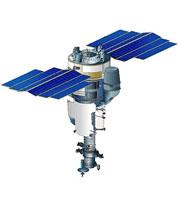 The PAMELA satellite: click here to see detailed diagram.© Firenze/INFN
The PAMELA satellite: click here to see detailed diagram.© Firenze/INFNThe first satellite built to detect antimatter in space launched safely yesterday, boosting the chances of identifying the mysterious 'dark matter' that makes up more than 80% of the stuff in the Universe.
The PAMELA probe (Payload for Antimatter Matter Exploration and Light-nuclei Astrophysics) took off from the Baikonur Cosmodrome in Kazakhstan on 15 June, carrying instruments that will catch antiprotons and positrons, the mirror particles of protons and electrons.
High-energy particles from elsewhere in the Universe, called cosmic rays, constantly rain down onto the Earth: some are neutrons, some are atomic nuclei and some are antimatter. But previous attempts to survey the drops of antimatter in the downpour have been restricted to balloon flights. These last for days or weeks at most and catch a mere handful of the elusive antiparticles that are almost entirely absorbed by the Earth's atmosphere. "That's why you have to go to space," says Sam Ting, a high-energy physicist at the Massachusetts Institute of Technology, Cambridge, and winner of the Nobel Prize for physics. "PAMELA is a great experiment to do that."
The probe will spend three years in space, and should catch thousands of antiparticles during its mission. "It's the first serious, dedicated space experiment to detect cosmic rays," says Felix Aharonian, an astrophysicist from the Max Planck Institute in Heidelberg, Germany.
The great accelerator in the sky
The antiparticles are produced in space when cosmic rays travelling close to the speed of light smash into interstellar gas, producing a shower of particles containing a small percentage of antimatter.
Similar collisions happen in particle accelerators, such as those at the CERN facility near Geneva, Switzerland. These collisions have helped to uncover the bestiary of subatomic particles that form the building blocks of matter, and the quantum theory that predicts how they interact.
The antimatter measurements from balloon experiments are broadly consistent with the physics going on in particle accelerators, explains Wolfgang Menn, a physicist at the University of Siegen, Germany, and part of the PAMELA team.
"But the statistics from balloons are so poor that we can't really be sure how much we can exclude different physics," he says. The antimatter may hold clues about the nature of dark matter, for example.
PAMELA should be sensitive enough to detect the slight excess of antiparticles that would be produced by collisions with one type of dark-matter candidate, generally known as a WIMP (Weakly Interacting Massive Particle). Although they have never been produced on Earth, the enormous speeds of some cosmic rays produce collisions that cannot be achieved in manmade particle accelerators, so it's the best place to look for their signature, says Menn.
The physicists' day in the sun
The project began in 1995 as a collaboration between Russian and Italian scientists, which expanded to include colleagues from many other countries.
Unusually, the big space agencies ESA and NASA have had very little to do with it, possibly because PAMELA has always been led by particle physicists rather than space scientists, Menn suggests. "And we always had good contact with the Russians; it's a lot cheaper to fly on one of their launchers," he adds. The team estimates that the project has cost around €25 million (US$32 million), at least a tenth of what a similar NASA probe might have cost. But Menn admits that the lower investment also means less manpower, so PAMELA has taken a lot longer to get into space than comparable ESA probes.
ADVERTISEMENT
Ting is leading a similar experiment called the Alpha Magnetic Spectrometer (AMS), which he hopes will be 1,000 times more sensitive than PAMELA when it is installed on the International Space Station (ISS) at the end of the decade. The completed instruments will be sent to Europe for testing later this year, he says, and the whole package should be at the Kennedy Space Center in Florida by 2008.
But the $1.2-billion AMS project depends on the Space Shuttle to get into space. With NASA promising to retire its ageing shuttle fleet in 2010, and the ISS far from completion, it is difficult to predict when, if ever, AMS will get to feel the antimatter raindrops patter.
Visit our orvirtue_rewarded.html">newsblog to read and post comments about this story.
